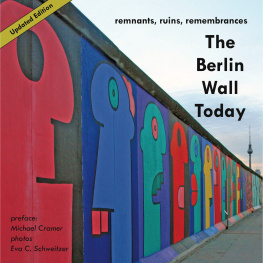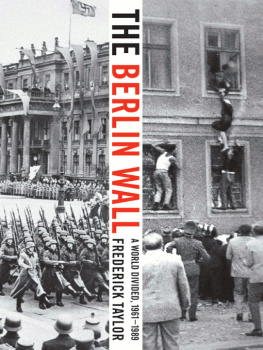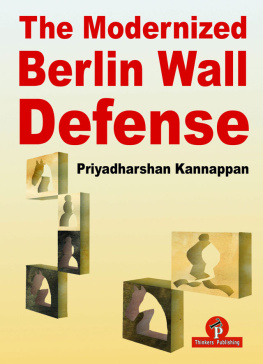Praise for The Berlin Wall Today
This comprehensive, well-illustrated book offers the reader fascinating insights into the worlds most notorious Wall.
Paul Sullivan, www.slowtravelberlin.com
A picturesque tour to the remembrances of the Wall that gives you a unique feeling about Berlin history.
Dorothee Dubrau, former Planning Commissioner in Berlin-Mitte
This book, with images strikingly new and refreshingly unfamiliar, highlights the dark history of the Wall as well as its political and artistic legacy as a canvas and cultural landmark today. Readers will be rewarded with a multi-faceted manual to understanding both the complexity and significance of a world famous symbol.
Justinian Jampol, director of the Wende Museum, Los Angeles

The Berlin Wall Today
By Eva C. Schweitzer, Ph. D. and Michael Cramer
Published 2011 by Berlinica Publishing LLC
Second updated edition in 2015
255 West 43rd St., Suite 1012, New York, NY, 10036; USA
Berlinica Publishing UG
Editor: Eva C. Schweitzer
Translator: Cindy Opitz
Printed in the United States by LightningSource
All rights reserved under International and Pan-American Copyright Law. No part of this book may be used or reproduced in any manner whatsoever without written permission except in the case of brief quotations embodied in critical articles and reviews.
Illustrations
Opposite page: East Side Gallery, Jolly Kunjappu, Dancing to Freedom
Andreas Schoelzel:
Landesarchiv Berlin: , back cover; all other photos: Eva C. Schweitzer
Maps: Open Street Map
Cover photo: Eva C. Schweitzer; the original painting is by Thierry Noir, at the East Side Gallery in Berlin.
ISBN Print: 978-1-935902-10-2
ISBN ebook:
978-1-935902-12-6
978-1-935902-08-9
978-1-935902-07-2
LCCN: 2011907211
www.berlinica.com
B ERLIN P ARTNERS, the Citys Tourism Agency, has created an interactive map to explore where the Berlin Wall has been. To see it step by step, click on the map (in the ebook) or on the link at http://www.berlin.de/mauer/verlauf/index/index.en.php


Contents
W HERE W AS THE B ERLIN W ALL ?
BY M ICHAEL C RAMER
Where was the Wall? is a question that many visitors to Berlin ask, since there are only a few remnants left of the Wall. Immediately after its fall in November 1989, the Berliner Mauer, the Berlin Wall was taken down so thoroughly that almost all traces of the inner-city border were erased. And in the years after the Wende (turn-around, the expression Germans use to refer to the fall of the Wall), the city of Berlin changed so dramatically that even Berliners can barely remember the exact location of the Wall. Teenagers now know of the era before 1989 only from history books.
But meanwhile, many people think removing the Wall was a mistake, and there are organizations and initiatives that want to make the twenty-eight-year division of the city visible for future generations. This book, which traces the remnants of the Wall with more than one hundred color photographs, is a guide for Berliners and visitors alike to what is left of the Wall, to the last concrete slabs, the guard towers, the lampposts, the graffiti-covered back portions of the Wallthe so-called Hinterland Mauer, a second security wall bordering the eastern part of Berlinand the memorial sites that remember the persecuted and the dead.
Even though most of the Wall was demolished, some parts of the original construction have remained, mostly at the Wall Museum at Bernauer Strasse, and at Niederkirchner Strasse, near the Berlin Parliament and the Topography of Terror Museum. But there is more. The course of the Wall that cut through the inner citytwenty-five miles altogether, and twelve feet highis marked by a double-row of cobblestones with copper plaques at regular intervals bearing the words Berliner Mauer 19611989, even running through some subway and S-Bahn stations. The Hinterland Mauer has been preserved at Nordbahnhof, Mauerpark, and, most importantly, at the famous East Side Gallery. Most of it is covered in graffiti today.
The entire Wall around West Berlin was a lot longer than the inner-city Wall; it was one hundred miles long. Its appearance and location have changed over time, also as a result of numerous territorial exchanges. The original barbed-wire fencing of 1961 was replaced by pre-manufactured Wall segments a few months later, which were reinforced in some places with metal-grid fences. To the initial outer border wall (uere Grenzmauer) facing west, with its trademark bulky top, the Hinterland Mauer was eventually added, the inner border wall (innere Grenzmauer) facing east.
Between the two lay the notorious Todesstreifen (death strip), a sandy wasteland more than a hundred yards wide, with the Kolonnenweg, or patrol road, in the middle. There the armed border troops of the German Democratic Republic (GDR) guarded the frontier with their fierce German shepherd dogs. On the West Berlin side, there was a Zollweg (customs path), built for the police and the Allied patrol vehicles. Only rabbits thrived in this urban desert.
Victims of the Wall
After the Wall was built, only government-approved people were allowed to live in the apartments directly behind the Wall in the eastern part of Berlin. Their friends and relatives had to be registered before any visits and were required to obtain special permits. More than three hundred guard towers, floodlight systems, signal and alarm fences, dog-runs, and tank traps were installed to prevent East Germans from escaping to West Berlin. Before the construction of the Wall, about four million people successfully escaped the GDR. Even afterward, Easterners, especially young ones, kept trying to cross the barricades, despite the danger. Between 1961 and 1989, the West Berlin police registered a total of 5,075 successful escapes at the Berlin Wall, 574 of which were desertions of GDR border troops. According to recent research, at least 128 people lost their lives at the Berlin Wall during such attempts, and even more at the border between East Germany and West Germany. Eighty border guards responsible for these deaths were identified after the end of the GDR and brought to court. Seventy-seven of them received a suspended sentence, but no jail time.
The first victim of the Wall who was killed by GDR boarder guards died on August 24, 1961. It was twenty-four-year-old Gnter Litfin. He was shot when he attempted to swim to the West Berlin side of the Humboldthafen. A memorial plaque at the Sandkrug Bridge in the Western part of Berlin is dedicated to him. The final fugitive to be shot dead at the Wall was twenty-year-old Chris Gueffroy. He was killed on February 5, 1989, in a rain of bullets, as he attempted to swim across the Britzer Canal to Neuklln, in West Berlin. On June 21, 2003, on what would have been his thirty-fifth birthday, a monument was put up at the site. The stories of all the murdered fugitives have been researched and published at www.chronik-der-mauer.de.
Immediately after the fall of the Wall, many environmental and transportation initiatives began with the aim of developing the former Wall area as a bicycle trail and tour. In order to win support for their initiative, supporters put up bike pictograms in many places along the eastern patrol road. Unfortunately, GDR border guards, who were still responsible for the Wall until October 2, 1990 (the reunification of Germany), removed many of the signs and tore up the paved road. They got the order: You built the Wall, now you have to take it down, and they did it with Prussian-Socialist effiency.












